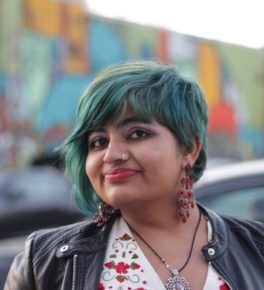Photo Credit: This graphic features an illustration from graphic artist, Lola Ogbara. Her work "explores sexuality and body forms," specifically of people of color.
This LGBTQ Pride Month, we sat down with Naushaba Patel from the Lesbian Health Initiative (LHI) of Houston to explore Naushaba’s vision for LGBTQ-empowering health programs and advocacy that come “from a place of love and a place of connection.”
“Pride has this dual purpose,” Naushaba explained. “Let’s celebrate what progress we have made, and at the same time, let’s be vocal about all the work that still needs to be done.” This perspective informs LHI’s work throughout the year. LHI connects LGBTQ people to needed health services, engages in local advocacy efforts and provides educational programs.
 |
| Pictured: Naushaba Patel from the Lesbian Health Initiative (LHI) of Houston. |
To achieve the dual purpose of pride – both celebration and action – Naushaba explains that two lenses are critical: an intersectional lens and a “joy and excitement lens.”
Assigned a female gender at birth, Naushaba identifies as queer and uses they/them/their pronouns. Also a Pakistani immigrant and a Muslim, they want to build spaces that center the experiences of people with multiple marginalized identities within the queer community. Naushaba recalls learning about marginalized identities as part of public health education and thinking “I am so many of these identities.” Naushaba “wanted to utilize what I learned in public health in terms of social determinants and looking at health from a complex, broader perspective and apply that to communities of color and sexual and gender minority communities.”
As a regional coordinator for the Raising Women’s Voices initiative (co-coordinated by Community Catalyst’s Women’s Health Program), LHI participated in successful work to promote Open Enrollment Period 5 last fall, especially among diverse LGBTQ people. Naushaba worked with Raising Women’s Voices to create social media badges, flyers and messages that were LGBT affirming and inclusive, “not just white LGBT affirming, but messaging specifically about diversity within the queer community that featured larger bodied queer people and queer women of color.” These messages addressed the specific concerns that were common in Naushaba’s queer community spaces, such as explaining that individuals can choose their own doctor rather than be forced to visit a doctor that is not affirming of their gender, sexuality or life experiences.
Approaching public health from an intersectional lens means recognizing and centering the experiences of people who sit at the intersection of multiple different marginalized identities. LGBTQ health work is more relevant when one “brings language justice, disability justice, intersex activism and undocumented folk into the work,” Naushaba said. To do this, Naushaba describes being intentional about which populations lack a seat at the table and how to focus on building trust with those who are not traditionally included. This is evident, for example, in LHI’s LGBTQ+ Femme Veteran Group, a one-of-its-kind group that addresses the increased health risks this group faces, including higher rates of trauma, substance abuse and mental illness.
Through work at LHI, Naushaba also advocates for the importance of a “joy lens.” “Instead of just highlighting when a trans woman of color has been killed and she becomes a number,” Naushaba says, “Let’s talk about our lives when we are alive. Let’s talk about all that we have accomplished. Let’s build spaces for healing that aren’t just centered on stigma conversations. Let’s have joy and celebration.”
At LHI, Naushaba runs a series of workshops that address “whole health” – not just disease and risk, but “wellness and pleasure as well.” LHI’s Positive Understanding of Sex, Sexuality and Yourself (or PUSSY) workshop series, for example, takes conversations about sexuality “away from a sterile conversation mode which talks only about consent as a legal thing, contraception and STIs.” Instead, Naushaba brings sexuality education “into the realm of pleasure” and facilitates conversations around “fat-phobia, homophobia, and transphobia, the shaming of brown bodies, hairy bodies and non-binary bodies and how our socialization influences our ability to have agency in our sexuality.” Naushaba powerfully describes this work as addressing health disparities in a way that incorporates the full humanity of the individual.
Together, the intersectional lens and the joy lens allow Naushaba to create spaces “where people can bring their entire selves to the table.” This approach provides an example for work in communities or at the state level, whether it’s in promoting health insurance literacy, conducting outreach and enrollment or carrying out grassroots organizing and policy advocacy. For LGBTQ Pride Month, advocates can join Naushaba in celebration and action by adopting messaging that addresses people with multiple marginalized identities and by recognizing the diverse lived experiences of people in their community.
Tess Solomon is an intern for the Women's Health Program at Community Catalyst, she is currently pursuing her Master of Public Health degree from Columbia University's Mailman School of Public Health.
